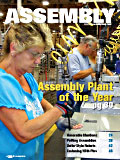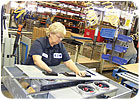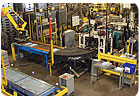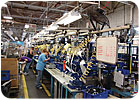
“If you ever plan to motor West . . . get your kicks on Route 66” are lyrics from a popular song performed by Nat King Cole in the mid-1940s and Chuck Berry in the early 1960s. The legendary road winds 2,400 miles from Chicago to Los Angeles.
Lincoln, IL, a rural town named for America’s 16th president several years before he occupied the White House, sits along Route 66 and is home to the world’s largest covered wagon. Another local landmark is the 2010 Assembly Plant of the Year.
The 380,000-square-foot Eaton Corp. factory has been visible to motorists driving along the “mother road” since the late 1950s. It assembles more than 5 million electrical devices annually.
A wide variety of products are produced by 436 Eaton associates in the 52-year-old facility, including load centers, metering devices, power outlet panels, air conditioner disconnects, and generator transfer switches. In addition, the plant houses a separate flex center that builds custom products to customer specification.
The products built in Lincoln are used in homes, apartment buildings and small businesses. Some items even show up in unusual places, such as offshore oil platforms and amusement parks. Eaton’s customers include electrical contractors, electrical supply wholesalers and distributors, builders, retailers, utilities and original equipment manufacturers.
The Lincoln plant is vertically integrated, with metal stamping and powder coat paint operations feeding multiple assembly lines. A team of on-site engineers support new product development and maintenance of line activities.
The 7th annual Assembly Plant of the Year award is sponsored by ASSEMBLY magazine and The Boston Consulting Group Inc. (BCG). Eaton Corp.’s facility in Lincoln was chosen for the award because it has remained innovative and cost-efficient, despite the challenging housing market. Specifically, the plant:
- Has achieved more than $15 million in savings over the last three years, much of it due to lean manufacturing initiatives and investments in new production technology. Sales per employee improved 20 percent over a three-year period.
- Is engaged in high-mix, high-volume production. The plant has multiple assembly lines that produce a wide variety of different models. Its in-house flex center designs many custom products.
- Has reduced the cycle time in its four product family value streams by more than 40 percent.
- Has taken aggressive steps to reduce product warranty costs through assembly line innovations and quality assurance.
- Operates an in-house machine building department that has created many one-of-a-kind automated assembly machines.
- Has launched more than 1,000 new products in the last three years. The in-house engineering team designe most of those products for cost-efficient assembly and customer value.
- Has pursued a number of green manufacturing and safety initiatives.
“There were a lot of deserving nominees for this year’s award,” says Michael Zinser, partner and managing director in BCG’s Chicago office and a co-leader of its global manufacturing practice. “But, Eaton’s Lincoln facility stood out based on its strong overall performance and its ability to continuously improve, even during the difficult market environment we’ve witnessed these past couple of years. We were particularly impressed by Eaton’s ability to manage, and even decrease, its unit cost position despite significantly lower volumes, and while maintaining its incredibly high standards of quality and delivery.
“Many organizations claim to have lean programs, but they often fail to sustain their improvements over long periods of time,” adds Zinser. “This isn’t the case at Eaton. The production system and lean think-ing have become an embedded part of the culture where employees constantly strive for competitive advantage in their operations. With this mindset, we believe Eaton will continue to set new bars for its industry, despite the pressures from an increasingly competitive marketplace.”
“Throughout its history, this plant has successfully managed through many changes, including product line moves, integration activities, new product industrializations, plant infrastructure, business cycles and market requirements,” says Rick Wyatt, plant manager. “The key to our success is a strong drive for high performance, continuous improvement, willingness to drive innovation, customer engagement, and our belief in excellence and empowerment of our people.
“The Lincoln plant has been a leader within Eaton in the areas of customer satisfaction meas-ured by product availability and quality, and cost competitiveness,” adds Wyatt. “Over the past three years, the facility has experienced significant challenges due to the decline in the residential market. Despite that, the Lincoln plant has continued to improve or sustain its leading performance indicators and has exceeded financial expectations.”
The 2010 Assembly Plant of the Year is a key part of Eaton, a $12 billion diversified power management company based in Cleveland. Eaton is a global technology leader in electrical components and systems for power quality, distribution and control; hydraulics components, systems and services for industrial and mobile equipment; aerospace fuel, hydraulics and pneumatic systems for commercial and military use; and truck and automotive drivetrain and powertrain systems for performance, fuel economy and safety.
The Lincoln plant, which is part of the Residential Products Div., is a top performer within Eaton. In fact, the facility has been the recipient of many honors, such as two recent back-to-back Eaton Business Excellence (EBE) Premiere Plant Honoree recognitions and numerous community service awards.
The EBE process, modeled around the Malcolm Baldrige National Quality Award, assesses the internal deployment and execution of the rigorous Eaton Business System (EBS). All Eaton plants, support functions and business units are assessed every two to three years.
“Deployment of EBS is very mature at this site,” says Wyatt. “Despite many challenges, the Lincoln organization has delivered consistent year-over-year improvement in every key metric during the past six years. We have positioned ourselves as a leader in our industry and within Eaton.
“We achieved our accomplishments through our team and our approach to driving change,” explains Wyatt. “We engaged our greatest asset, our employees, to drive continuous improvement in our operations and to help us sustain high performance.”

Lean Philosophy
EBS is the foundation for all actions at the Lincoln plant. The system integrates tools and processes that are deployed throughout the facility. Standard operational tools that are deployed and mature in Lincoln include the Eaton Lean Six Sigma process (ELSS), the Eaton Quality System and Eaton Philosophy Work Practices.“These tools are the backbone of our overall approach to driving continuous improvement,” says Wyatt. “They outline how we perform our work on a daily basis and drive performance improvement. Each lean tool, such as 5S, TPM and standard work, has a senior leader as champion who is responsible for driving deployment throughout the facility.
“Continuous improvement targets for our key metrics flow down from the leadership team to the organization,” claims Wyatt. “Goals are established for all employees and performance against these goals is measured on a semiannual basis.”
All Lincoln employees, who average 18 years of service, have embraced Eaton’s lean philosophy. In fact, they have played a direct role in voicing their opinions and sharing new ideas.
The 2010Assembly Plant of the Yearuses several methods to gather input. “We have the normal suggestion box where ideas can be sent to the plant manager,” says Maria Stephenson, technical services manager. “In addition, we have various two-way meetings conducted daily, weekly and monthly; an annual employee survey; and employee involvement teams. Ideas captured during two-way meetings are transferred to an action list and updated semimonthly.
“Employee involvement (EI) teams consist of employees who meet weekly to work on ideas they have to improve products and processes that pertain to their assigned work areas,” adds Stephenson. “They focus on removing waste from the value stream by reducing setup times, standardizing components, or suggesting changes to design that improve quality, productivity or ergonomics.
“The EI teams have an annual cost-out goal and have met or exceeded their targets the past several years,” Stephenson points out. “We have achieved more than $1 million in cost avoidance over the last two years.”
An aggressive goal for 2010 is also set. “However, this will be a challenging year due to the current economic climate,” notes Wyatt.
Suppliers also play a key role in helping the Lincoln plant operate cost-effectively. “To grow our market share and add value for our stakeholders, we are continually challenged to drive cost out of our processes, while maintaining a quality product at a competitive price,” says Wyatt.
“The supply chain team works with our suppliers to reduce the cost of components and raw materials,” explains Mike Fitzgerald, controller. “Local actions are set in conjunction with the Eaton corporate supply chain team and are monitored through our monthly cost-out meeting.”
The Innovation Drives Excellence, Achievement and Savings (IDEAS) program is the formal process that suppliers use to recommend changes that reduce costs. In the last three years, the Lincoln plant has implemented more than $900,000 in cost savings and improvements from the IDEAS program.
“Our design and engineering groups drive out cost by improving manufacturing methods, optimizing designs and changing raw materials,” Fitzgerald points out. “This input is gathered from customers, marketing, EI teams and operations personnel.
“This is accomplished through reviewing potential opportunities for our products and processes,” adds Fitzgerald. “For example, we monitor sales trends of our products and will invest in tooling design and processing methods that will allow for advanced tooling and higher levels of automation. Conversion to progressive stamping tools and a new robotic paint spraying system are some examples recently implemented.”

Project Runway
Five years ago, the Lincoln leadership team devised a manufacturing vision called Project Runway to ensure the plant’s long-term success. The goal was to increase capacity each year, achieve 30 percent growth, drive cost out, and improve flexibility without adding floor space. A slogan, “Protecting our Future in the Heartland,” was chosen to energize the workforce as change occurred.People, production processes and equipment have been realigned using value streams to ensure productivity. For instance, the load center product family processes were realigned and lean tools implemented. This reduced the processing distance from 10,700 feet to 4,000 feet, resulting in a 46 percent cycle time improvement.
“Our goal is to provide cost-competitive, high-volume assembly and customized products with a focus on customer solutions,” says Wyatt. “This manufacturing strategy incorporates automated assembly equipment, which improves quality performance and productivity, while enhancing ergonomics.”
“Project Runway has been developed to drive continuous improvement within the operation,” says Stephenson. “We have a defined strategy for each product family that includes the introduction of or improvement to existing automated equipment in fabrication and final assembly. This equipment is designed with tools that verify quality during the build process. The tools applied include sensors, depth gauges and torque verifiers.
“As a result of Project Runway, various fastening methods that are automation-friendly have been designed into our products and processes,” Stephenson points out. “One example is the automated hinge-door equipment built in 2009. This assembly equipment is aligned with the stamping press, eliminating the extra handling of parts and improving the quality of the part. Vision systems have also been introduced in both assembly and fabrication.”
“Vision technology is used to measure a critical dimension on our fabricated stamped door press,” explains Lan Tran, operations excellence manager. “As each door passes through the vision system, measurements are taken and recorded onto a moving run chart.
“Our small load center assembly line also employs the vision system, which is being deployed to compare components within the assembly to the standard,” adds Tran. “This ensures that there are no missing or incorrect parts, which can be a defect mode on this line.”
“Similar projects have been undertaken by our workforce in other high-volume product lines,” says Stephenson. “By leaning out the entire value stream, focusing capital purchases on automation or technology-enhanced equipment, and building quality into the process, we have been able to produce residential electrical products competitively in the United States.”
The latest project is a robotic paint spray process that was installed a few months ago to support high-volume products. In the future, the Lincoln facility plans to expand the use of robots for other paint applications.
Manufacturing engineers are also investigating an automated conveyor system or automated guided vehicles for moving finished goods throughout the plant. Another initiative involves software and DC electric fastening tools to allow operators to record and compare actual torque readings during assembly.

Diverse Products
Many of the products assembled at the Lincoln plant appear to be similar on the outside, but are actually much different on the inside. That’s because many power companies and municipalities have local fire codes and standards that affect residential electrical products.There are also specific customer preferences that must be satisfied. As a result, the plant has flexible assembly lines dedicated to specific locales. For instance, there’s a line that makes metering boxes for apartment buildings and another line for residential load centers destined for the international market.
Load centers make up a major part of the plant’s volume. The typical product consists of a rectangular metal enclosure with a hinged door. The interior contains a wide variety of bus bars and other aluminum, copper and plastic components that distribute and control electricity for homes or light commercial buildings. Contractors and builders buy the boxes and electricians fill them with different types of circuit breakers, including arc fault breakers, which can reduce the potential of electrical fires.
During its operating hours, the 2010Assembly Plant of the Yearbuilds, on average, one electrical device every 36 seconds. A wide variety of options are available to customers. In fact, more than 600 different load center variations are built by Lincoln assemblers. Distinguishing factors include varying amperage ratings, number of circuits, size of breakers, depth of cases, material and process of manufacturing of the bus bars, number of neutral connections, color of product and accessories.
Assembly methods widely used in the plant include screwdriving, riveting, heat staking and toxing. Screwdriving and riveting are used to install metal components. Heat staking, a mix of compression, heat and varied dwell times, is used to fasten molded components to steel components in subassemblies. Toxing, welding and screwdriving are used to fasten metal enclosures.
Typical steps in the load center assembly process involve the installation of neutral bars to the case and bonding a strap to a neutral assembly. Next, the panel assembly is mounted into the case and the main breaker is installed, torqued and verified. The cover is then installed and the product is packed, stacked and transported to the shipping area.
“The process is driven by our drawings and assembly practices,” says Joe Blankley, manufacturing manager. “Through the use of standard work, visual work instructions and in-process quality checks, we ensure that we are building a quality product that exceeds customer expectations.
“The most challenging part of high-mix assembly is planning material flow to ensure that all of the parts are available when required,” adds Blankely. “We use a monthly Sales, Inventory and Operational Planning (SIOP) process to determine the demand by style number, and a combination of kanban and material requirements planning (MRP) to identify and time the delivery of the detailed parts.”
Metering products are complex devices built at Lincoln on a daily basis. The average product uses 40 to 50 different components to make one finished assembly. There are more than 600 different variations overall, requiring more than 5,000 different components. A number of different tolerances have to be met regarding arcing and torquing. For instance, 84 different checks and torque settings are required.

In-House Machine Building
One of Lincoln’s strongest advantages is its in-house machine-building capability. The plant operates a 3,200-square-foot facility, first established in 1987. It originally focused on supporting automated equipment purchased outside the company. Since then, the focus has changed to include designing, building and sourcing most of the automated equipment used in the plant.
This facility and the group that supports it is part of technical services. The team designs equipment that enables the plant to reach its productivity, capacity and quality targets by working with various departments.
With their manager, the in-house shop reviews the plans for Project Runway and other strategic initiatives, as well as investigating opportunities discovered at other operational meetings or during participation in lean activities. They then propose new equipment or modifications to existing equipment.
“In the last three years, the team has completed 12 automated machines of various sizes,” says Lonzo Putman, tooling and automation manager. “We still have two machines in process for 2010. This capability allows us to save cost and reduce our response time for installation of new equipment.”
The shop has built several assembly machines recently, such as:
- A device that automatically fastens hinges to doors and is inline with a stamping press, eliminating handling and work in process (WIP).
- An automated storage-retrieval system that inspects stamped doors and stacks accepted doors ergonomically in a drawer to be used by the paint line loaders. “This eliminates additional handling and improves ergonomics,” explains Stephenson.
- Several automated pick-and-place devices used to eliminate manual loading, improving ergonomics, productivity and WIP.
- Various automated subassembly machines for the product families that improved productivity, quality and WIP.
- An integrated system, consisting of several pieces of automated equipment, to produce 14-inch cases. “This system eliminated manual assembly of the case, resulting in WIP elimination, quality improvements and productivity increases,” says Stephenson.
The 2010 Assembly Plant of the Year prides itself on meeting customer needs, especially if that requires custom, one-of-a-kind products. For the past 11 years, an in-house Flex Center has modified existing designs and created niche products.
The 2,400-square-foot facility is important to the Lincoln plant’s success, because there are thousands of different needs and hundreds of ways to distribute power.
“In certain applications, standard products will not meet the customers’ needs,” explains Eric Samuelson, P.E., engineering manager. “There is a need for custom solutions, and the Flex Center provides that opportunity.
“The Lincoln Flex Center is unique in that we can offer innovative custom solutions in a relatively short lead time,” adds Samuelson. “Eaton makes many of the various components that we utilize in custom product designs. This has led to growth in the Flex Center, customer loyalty and increased business on our standard product.”
Last year, the Flex Center contributed significantly to the total sales for the Lincoln plant. The team has created hundreds of unique and innovative designs. For instance, they recently developed a line of retrofit interiors that has been successful in helping customers upgrade their existing installations without removing the existing enclosure. It won the Product Show Case Award at an IEC Electric Expo for being the Best in Class Product.
“We also have designed solutions that integrate various systems, such as load centers, automatic transfer switches and surge protectors into a common panel,” says Samuelson. “This year, there also have been some new designs that are modifications of the new Eaton Commercial Pedestal product line.”
The Lincoln facility blends established Eaton practices and strong doses of entrepreneurship, work ethic and pride in its team and customer satisfaction. A combination of doing business right and innovation will continue to keep Lincoln a leader within Eaton and the market.
About the Award
The Assembly Plant of the Year award was initiated in 2004 to showcase world-class production facilities in America, and the people, products and processes that make them successful. All manufacturers that assemble products in the United States are invited to nominate their plants. Unlike many other awards, there is no entry fee.
The Assembly Plant of the Year award is sponsored by ASSEMBLY Magazine and The Boston Consulting Group Inc. (BCG), a global management consulting firm that is the world’s leading advisor on business strategy.
The goal of the Assembly Plant of the Year award is to identify a state-of-the-art facility that has applied world-class processes to reduce production cost, increase productivity, shorten time to market or improve product quality.
An official nomination form appeared on the magazine’s Web site earlier this year. Nominations were received from a diverse group of manufacturers that reflect the magazine’s demographics.
All nominees were evaluated by ASSEMBLY’s editorial staff and by BCG’s operations practice, based on criteria such as:
- Have assembly processes been improved through the use of new technology?
- Has the plant improved its performance by making more effective use of existing technology?
- Has the plant taken steps to reduce production costs?
- Have new or improved assembly processes resulted in increased productivity?
- Has the plant used assembly improvements to reduce time to market?
- Has the plant boosted bottom-line profits and competitive advantage?
- Did operators play a role in the successful implementation of new assembly strategies?
- Has a product been effectively designed for efficient assembly?
- Has the plant attempted to protect the environment and conserve natural resources?
Previous recipients of the Assembly Plant of the Year award were Batesville Casket Co. (Manchester, TN); IBM Corp. (Poughkeepsie, NY); Schneider Electric/Square D (Lexington, KY); Lear Corp. (Montgomery, AL); Xerox Corp. (Webster, NY); and Kenworth Truck Co. (Renton, WA).
A nomination form for the 2011 award will be available online in January at www.assemblymag.com.
Learn more about the 2010 Assembly Plant of the Year by clicking www.assemblymag.com for these Web Extra articles:
- Abe Lincoln Really Was Here!
- Ambitious Green Manufacturing Effort
- At Eaton Lincoln, Safety Is No Accident
- Behind the Scenes at Eaton Lincoln
- Customers Always Come First at Eaton Lincoln
- The Green Fields of Eaton
